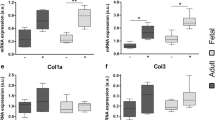Abstract
Connective tissue growth factor (CTGF) was examined in the structures of dermis of humans with different ages, from 20 weeks of pregnancy to 85 years. By immunohistochemistry, the fibroblasts and blood vessels positively stained for CTGF were observed in the dermis of all examined ages. An age-dependent increase in the percent of the fibroblasts and blood vessels positively stained for CTGF in the dermis was observed. A statistically significant negative correlation was found between the age-dependent changes in the total number of fibroblasts, percent of the fibroblasts with positive staining for proliferating cell nuclear antigen, and portion of the fibroblasts with positive staining for CTGF. Another statistically significant negative correlation was found between the age-dependent changes in the number of blood vessels and portion of the blood vessels with a positive staining for CTGF. The results suggest that CTGF has an inhibitory influence on the angiogenesis and fibroblast renewal in the human dermis through ontogenesis.
Similar content being viewed by others
References
Abraham, D., Connective tissue growth factor: growth factor, matricellular organizer, fibrotic biomarker or molecular target for anti-fibrotic therapy in SSc?, Rheumatology (Oxford), 2008, vol. 47, suppl. 5, pp. v8–v9.
Chen, Y., Abraham, D.J., Shi-Wen, X., et al., CCN2 (connective tissue growth factor) promotes fibroblast adhesion to fibronectin, Mol. Biol. Cell, 2004, vol. 15, pp. 5635–5646.
Chen, S., McLean, S., Carter, D.E., et al., The gene expression profile induced by Wnt 3a in NIH 3T3 fibroblasts, J. Cell. Commun. Signal., 2007, vol. 1, pp. 175–183.
Chen, C.C. and Lau, L.F., Functions and mechanisms of action of CCN matricellular proteins, Int. J. Biochem. Cell. Biol., 2009, vol. 41, pp. 771–783.
Cicha, I. and Goppelt-Struebe, M., Connective tissue growth factor: context-dependent functions and mechanisms of regulation, Biofactors, 2009, vol. 35, pp. 200–208.
Colwell, A.S., Krummel, T.M., Longaker, M.T., et al., Fetal and adult fibroblasts have similar TGF-betamediated, Smad-dependent signaling pathways, Plast. Reconstr. Surg., 2006, vol. 117, pp. 2277–2283.
Dammeier, J., Beer, H.D., Brauchle, M., et al., Dexamethasone is a novel potent inducer of connective tissue growth factor expression. Implications for glucocorticoid therapy, J. Biol. Chem., 1998, vol. 273, pp. 18185–18190.
Du, J., Klein, J.D., Hassounah, F., et al., Aging increases ccn1 expression leading to muscle senescence, Am. J. Physiol. Cell. Physiol., 2014, vol. 306, pp. C28–C36.
Gao, R. and Brigstock, D.R., Connective tissue growth factor (CCN2)induces adhesion of rat activated hepatic stellate cells by binding of its C-terminal domain to integrin alpha(v)beta(3) and heparan sulfate proteoglycan, J. Biol. Chem., 2004, vol. 279, pp. 8848–8855.
Gunin, A.G., Kornilova, N.K., Petrov, V.V., et al., Age changes in the number and proliferation of fibroblasts in the human skin, Adv. Genontol., 2011, vol. 3, no. 4, pp. 299–303.
Gunin, A.G., Petrov, V.V., Golubtzova, N.N., et al., Agerelated changes in angiogenesis in human dermis, Exp. Gerontol., 2014, vol. 55, pp. 143–151.
Gunin, A.G., Petrov, V.V., Vasilyeva, O.V., et al., Agerelated changes of blood vessels in the human dermis, Adv. Geronotol., 2015, vol. 5, no. 2, pp. 65–71.
Hall-Glenn, F., De Young, R.A., Huang, B.L., et al., CCN2/connective tissue growth factor is essential for pericyte adhesion and endothelial basement membrane formation during angiogenesis, Adv. Geronotol., 2012, vol. 7, p. e30562.
Inoki, I., Shiomi, T., Hashimoto, G., et al., Connective tissue growth factor binds vascular endothelial growth factor (VEGF) and inhibits VEGF-induced angiogenesis, FASEB J., 2002, vol. 16, pp. 219–221.
Kapoor, M., Liu, S., Huh, K., et al., Connective tissue growth factor promoter activity in normal and wounded skin, Fibrogenesis Tissue Repair, 2008, vol. 1, p. 3.
Kim, K.H., Park, G.T., Lim, Y.B., et al., Expression of connective tissue growth factor, a biomarker in senescence of human diploid fibroblasts, is up-regulated by a transforming growth factor-beta-mediated signaling pathway, Biochem. Biophys. Res. Commun., 2004, vol. 318, pp. 819–825.
Kubota, S. and Takigawa, M., CCN family proteins and angiogenesis: from embryo to adulthood, Angiogenesis, 2007, vol. 10, pp. 1–11.
Markiewicz, M., Nakerakanti, S.S., Kapanadze, B., et al., Connective tissue growth factor (CTGF/CCN2) mediates angiogenic effect of S1P in human dermal microvascular endothelial cells, Microcirculation, 2011, vol. 18, pp. 1–11.
Nishida, T., Kubota, S., Fukunaga, T., et al., CTGF/Hcs24, hypertrophic chondrocyte-specific gene product, interacts with perlecan in regulating the proliferation and differentiation of chondrocytes, Russ. J. Dev. Biol., 2003, vol. 196, pp. 265–275.
Petrov, V.V., Vasilyeva, O.V., Kornilova, N.K., et al., Agerelated changes in mast cells and eosinophils of human dermis, Russ. J. Dev. Biol., 2013, vol. 44, no. 3, pp. 139–143.
Quan, T., He, T., Kang, S., et al., Connective tissue growth factor: expression in human skin in vivo and inhibition by ultraviolet irradiation, J. Invest. Dermatol., 2002, vol. 118, pp. 402–408.
Safadi, F.F., Xu, J., Smock, S.L., et al., Expression of connective tissue growth factor in bone: its role in osteoblast proliferation and differentiation in vitro and bone formation in vivo, J. Cell Physiol., 2003, vol. 196, pp. 51–62.
Shi-Wen, X., Leask, A., and Abraham, D., Regulation and function of connective tissue growth factor/CCN2 in tissue repair, scarring and fibrosis, Cytokine Growth Factor Rev., 2008, vol. 19, pp. 133–144.
Smerdel-Ramoya, A., Zanotti, S., Stadmeyer, L., et al., Skeletal overexpression of connective tissue growth factor (ctgf) impairs bone formation and causes osteopenia, Endocrinology, 2008, vol. 149, pp. 4374–4381.
Suzuma, K., Naruse, K., Suzuma, I., et al., Vascular endothelial growth factor induces expression of connective tissue growth factor via KDR, Flt1, and phosphatidylinositol 3-kinase-akt-dependent pathways in retinal vascular cells, J. Biol. Chem., 2000, vol. 275, pp. 40725–40731.
Author information
Authors and Affiliations
Corresponding author
Additional information
Original Russian Text © O.V. Vasilieva, N.N. Golubtzova, F.N. Filippov, A.G. Gunin, 2016, published in Ontogenez, 2016, Vol. 47, No. 2, pp. 75–82.
Rights and permissions
About this article
Cite this article
Vasilieva, O.V., Golubtzova, N.N., Filippov, F.N. et al. Connective tissue growth factor (CTGF) in the human dermis through ontogenesis. Russ J Dev Biol 47, 63–68 (2016). https://doi.org/10.1134/S1062360416020089
Received:
Accepted:
Published:
Issue Date:
DOI: https://doi.org/10.1134/S1062360416020089




